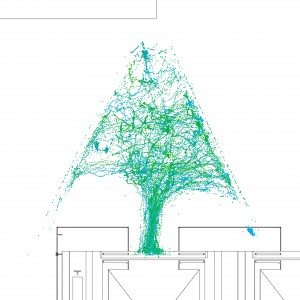…from cyberspace to space/people interactions” (or: making the building’s brain)
This project questions the concept and meaning of CYBERSPACE for understanding its implications to real-space. In a first stage I explore the idea of a “Cartesian Space”, a space in which abstract human data is represented. In this stage I seek to develop a way to track people in reality and transfer them to cyberspace as the core of a building’s “brain”.
 CYBERSPACE:”… A graphic representation of data abstracted from the banks of every computer in the human system. Unthinkable complexity. Lines of light ranged in the nonspace of the mind… clusters…” (Gibson, 1984)
CYBERSPACE:”… A graphic representation of data abstracted from the banks of every computer in the human system. Unthinkable complexity. Lines of light ranged in the nonspace of the mind… clusters…” (Gibson, 1984)
What is human scale in relation to cyberspace? What would that mean?
The concept of Cyberspace was first developed by Gibson in the eighties. The idea was to introduce our minds into a place in which we can connect with others and with data, which sounds pretty much like the internet. This idea faces the impossibility of transporting our bodies into Cyberspace because of obvious technological reasons: the computer interfaces were able to translate our thoughts but not our body-data.
Today, we have the depth cameras to “capture” our bodies. This kind of developments may bring some unexpected outcomes such as “The Building’s Brain”.
In 2012, a research group of the MIT Media Lab (Responsive Environments) decided to explore the use of Kinects for gesturally controlling 25 screens around their building, recording at the same time every path of a person walking in front of the sensors across a space. I started working three months ago with the data collected by this group, realizing these are exceptional findings – these data may constitute the only database of anonymized tracked people inside a building, perhaps in the entire world.
What we see in the images above are 6 random visualizations of 6 different locations inside the building E-14, from a top view. The Kinect sensing range is a triangle therefore the tracking visualizations are also triangles. The “Building E-14” may use this information to analyze and control what is happening inside of it. The depth cameras stream and capture every event that’s happening inside, therefore to retrieve information such as, how many people is inside a space, for how long, compare this information to schedules, day time, and protocols, is currently possible. The building’s brain has emerged.
Yet the idea is not a surveillance state of architecture but an interactive system that augments the information available for the occupants of the building qualifying its spaces for the user to choose where to go according to their intentions. For example the Building E-14 may suggest that a space is too crowded and a quiet person may choose to go somewhere else, or warn people that the doors will close soon. The Building’s brain may be a channel to interface between occupants and the architectural context.
For the occupants the way we understand space and socialize might change forever. For the designer this is a remarkable tool since from now on the interaction between the building and people’s motion can be recorded and analyzed in order to asses new designs.
Lobsters: CYBERSPACE
“…Let me think about it,” says Manfred. He closes the dialogue window, opens his eyes again, and shakes his head. Some day he too is going to be a lobster, swimming around and waving his pincers in a cyberspace so confusingly elaborate that his uploaded identity is cryptozoic: a living fossil from the depths of geological time, when mass was dumb and space was unstructured.
Next steps
Nicholas Negroponte (founder of the Media Lab) and his group “The Architecture Machine Group”, built in 1970 an experiment consisting of a controlled environment (a box) filled with small blocks and introduced a family of gerbils to inhabit it. The gerbils were in continuous observation in order to understand their performance inside the environment. A robotic arm would accommodate the blocks according to this processed data, hence the environment adapted endlessly to the gerbil behavior patterns. Assuming that it was just an experiment and, of course, that it worked sufficiently well, this experiment tests the possibility of a cyclical/adaptive/responsive/changing environment.
Consequently, the possible aim of this research would be: If we can track, for example, how many people goes inside of a rom of a party, and observe that the number of attendants exceeds the regulations “The Building” may decide to expand that room.











